Workshop Statistics: Discovery with Data and Fathom
Topic 10: Least Squares Regression I
Activity 10-1: Airfares
(a) Answers will vary from student to student. Might choose the mean, 166.92.
(b) Answers will vary from student to student, but some examples would
be which airline you choose to fly with, or the distance to the destination
city, how far in advance you book.
(c) Based on the scatterplot, knowing the distance would be useful
because there appears to be a fairly strong association between distance
and airfare.
(e) Answers will vary from student to student, but $130 is a good estimation.
(f) Answers will vary from student to student, but $260 is a good estimation.
(g) Answers will vary from student to student, but using our answers
from (e) and (f), slope = (260-130)/(1500-300)=13/120=.10833.
(h) Answers will vary from student to student, but using our answers
from (e) and (g), intercept = 97.5.
(i) Answers will vary from student to student, but using our answers
from (g) and (h), airfare = 97.5 + (.108) * distance.
(j) Answers will vary from student to student, but here is a possible
line:
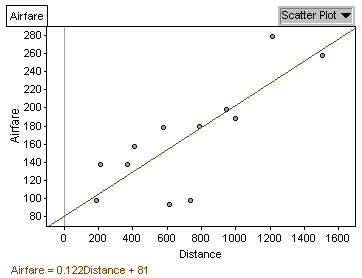
The equation for this line
is airfare = 81 + .122 * distance
(k) Answers will vary from student to student.
(l) Answers will vary from student to student, but the sum of squared
residuals for the above line is 14370.
(m) Answers will vary from student to student.
(n)
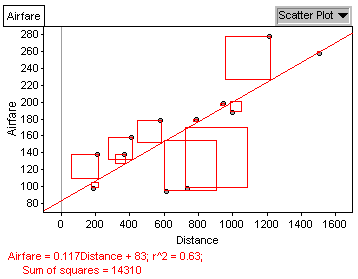
airfare = 83 + .117
* distance is the equation for the Least-Squares line. The
sum of squared residuals for this line is 14310.
Activity 10-2: Airfares (cont.)
(a)
| |
mean
|
std. dev.
|
correlation
|
|
airfare (y)
|
166.9
|
59.5
|
.795
|
|
distance (x)
|
713
|
403
|
|
(b) b =.795(59.5/403) = .117; a = 166.9-.117(713) = 83.479
(c) airfare = 83.479 + .117 * distance; this agrees exactly with Fathom's
equation (except that Fathom rounded 83.479 to the nearest integer)
(d) 83.479+.117(300) = $118.58
(e) $258.98
(f)
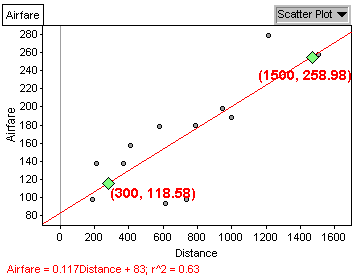
(g) Answers will vary from student to student, but a good estimate
would be $190.
(h) $188.78
(i) $415.99; This is probably not a reliable estimate since a
distance of 2,842 miles is well beyond our data set.
(j)
|
distance
|
900
|
901
|
902
|
903
|
|
predicted airfare
|
$188.78
|
$188.89
|
$189.01
|
$189.13
|
(k) Each mile adds about another $0.11, which is close to the slope of
our least squares regression line, .117.
(l) $11.70
Activity 10-3: Airfares (cont.)
(a) $150.87
(b) 178-150.87 = $27.13
(c) Atlanta: fitted - $150.87, residual - $27.13; Boston:
residual - $11.30; Chicago fitted - $155.10
(d) St. Louis has the largest residual: distance - 737, airfare
- $98, error - overestimate of $71.77
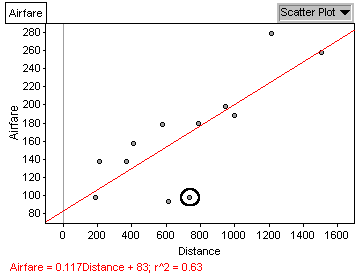
(e) greater
(f) below
(g) $111.08
(h) 4: Atlanta, Detroit, Pittsburgh, St. Louis
(i) Most cities have a smaller residual than their deviation from the
mean. This suggests that predictions from the regression line are
generally better than the airfare mean because least squares regression
takes the explanatory variable into account.
(j) sum of squared residuals: $14,308.09; sum of squared deviations
from overall mean: $38,882.92
(k) Answers will vary from student to student, but here is a good example:
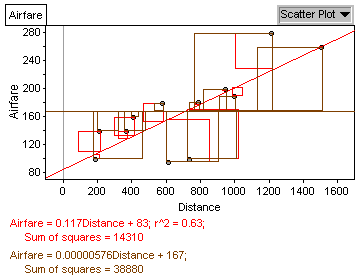
(l) 14308.09/38882.92 = .368, 1 - .368 = .632
(m) r = .795, r2 = .632; This is the same as the proportion
of variability in the response variable that is explained by the regression
model.
Activity 10-4: College Tuitions (cont.)
(a)
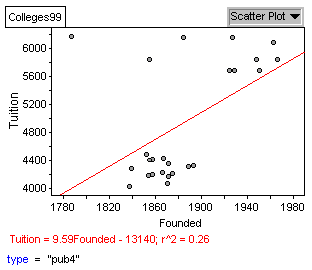
public: tuition = -13,138 + 9.59 * founded
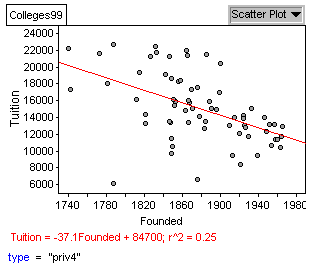
private: tuition = 84,719 - 37.1 * founded
(b) public: r2 = .257; private: r2
= .255; These two values for r2 are very similar.
(c) The line on the private college scatterplot appears to do a better
job of summarizing the relationship between tuition and founding year.
The points follow the linear relationship much more closely.
(d) public: $5,083; private: $14,229; Judging from the
scatterplot, the private school prediction seems more reasonable because
the points fall closer to the line in the area of 1900 on this scatterplot.






